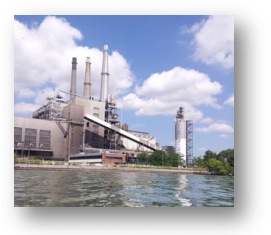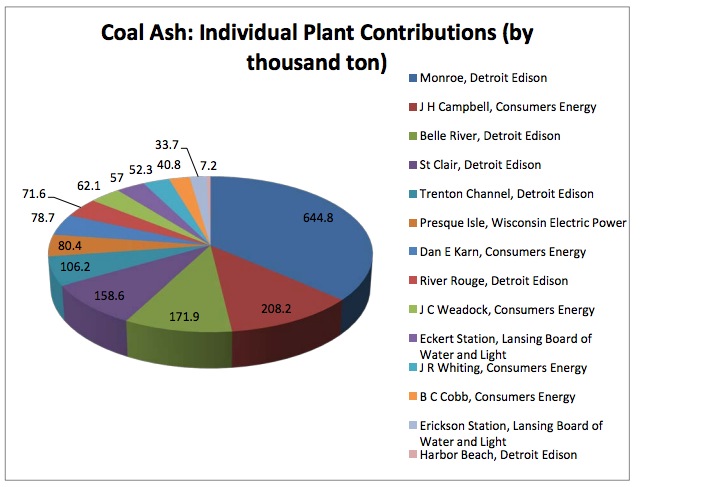Water defines, and is central, to Michigan’s economy. Major tourism, agriculture, and fishing industries depend on the health of rivers, lakes, and streams. The Great Lakes contain over 20% of the world’s usable fresh surface water. Unfortunately unmitigated coal ash pollution is a major threat to the health of the state’s water and economy.
More than 1.7 million tons of coal ash, the toxic byproduct produced by coal-fired power plants, is generated every year in Michigan. Managing and storing this amount of waste safely is a challenge and presents health and environmental risks to Michigan’s communities. A lack of federal protections, weak state regulations, outdated and unregulated storage areas, and historic coal ash contamination sites threatens the state’s “Pure Michigan” heritage and the Great Lakes.
There are twenty-nine known coal ash sites in Michigan. Nineteen are within five miles of a Great Lake or a bay of a Great Lake, with several sitting directly adjacent to a bay. Three sites are within twenty miles of the Great Lakes. Every single coal ash impoundment or landfill sits on or near one of the state’s lakes, rivers, streams, and wetlands.
The Twenty-nine known coal ash sites in the state include several different types of sites:
- Nine open Type III Low Hazardous Industrial Waste landfills and surface impoundments, which are licensed by the state’s Office of Waste Management and Radiological Protection division (solid waste) at the Michigan Department of Environmental Quality (MDEQ.)
- Five all, or mostly closed, Type III Low Hazardous Waste Landfills and surface impoundments.
- Nine “Contained waste” coal ash storage ponds that are completely unregulated by the state’s solid waste authority, unless they meet the state’s definition of a dam.
- There are a total of 20 open ponds spread across these nine sites.
- Six historic coal ash storage areas classified by MDEQ as “Part 201” Brownfield contaminated sites.
Of the fourteen sites that were regulated by the state at some point as Type III coal ash storage areas, twelve are either known to be contaminated or considered “likely contaminated.” MDEQ has reported eight sites as contaminated to the U.S. Environmental Protection Agency (EPA). Clean Water Fund’s research found four additional “likely” contaminated sites. That’s nearly 86% of the regulated storage sites. There are an additional six known historic contamination sites that have been identified by the state as Part 201 Brownfield sites. Unfortunately, because of a lack of data, it is unknown whether numerous unregulated “contained waste” storage ponds are also contaminating the state’s water.
In addition to the threats posed by leaking coal ash storage sites, there are other serious problems created by coal ash pollution. Several of the Brownfield sites include areas where coal ash was historically disposed of in unlined pits or trenches as construction fill, which is allowed under “beneficial reuse” provisions of Michigan law. Disposing of coal ash in this manner exposes the surrounding community to contamination during storm events. Moreover, the majority of power plants in the state are allowed to discharge toxic pollution directly into the state’s water without limiting harmful pollutants like mercury and lead.
The state is not living up to the promise of “Pure Michigan.” The Governor’s 2014 2015 Executive Budget provides the “Pure Michigan” tourism campaign with $29 million5 from the state’s general fund allocations. In contrast, the Michigan Department of Environmental Quality (MDEQ) is only allocated $28.1 million which must cover all of the department’s work including oversight of solid waste and clean-up programs. This limited funding for environmental regulation puts Michigan’s water at risk.
The state can and must do more to protect public health and water quality by overseeing handling and disposal of coal ash and clean-up contaminated and leaking coal ash sites. Weak state regulations are compounded by the absence of strong U.S. Environmental Protection Agency (EPA) rules addressing the long-term disposal of coal ash and water pollution from power plant coal ash ponds. EPA risk assessments have long shown that the dangers of coal ash pollution and the risks to human health and the environment are real. These assessments show the need for strong regulations to prevent water and air pollution and to protect public health. However, in practice, coal ash is less regulated than household trash.
Coal ash contamination is preventable. Yet, without minimum federal standards to control this toxic waste, coal ash will continue to be managed through a patchwork of weak state standards. This situation has allowed the water, air and land in at least 37 states to be poisoned, including Michigan.
Download full version (PDF): Coal Ash in Michigan
About Clean Water Fund
www.cleanwaterfund.org
Clean Water Fund is a national 501(c)(3) research and education organization that has been promoting the public interest since 1978. Clean Water Fund supports protection of natural resources, with an emphasis on water quality and quantity issues. Clean Water Fund’s organizing has empowered citizen leaders, organizations and coalitions to improve conditions of hundreds of communities, and to strengthen policies at all levels of government.
Tags: Clean Water Action, Clean Water Fund, Coal, MI, Michigan, Toxic Trash Exposed








 RSS Feed
RSS Feed